Table of Contents
Stroke Analysis
In this section an analysis of the kick drum mallet movement is performed using a high speed camera, a tiny Qt application and some basic vector math.
Two types of analysis are performed:
- A single hard kick drum stroke.
- A series of strokes at relatively high tempo (resembling approx 200bpm kickdrum roll).
These two types of strokes are the result of very different playing styles and should cover the most basic uses of the kick drum in metal music.
The experiment was performed on an Axis Longboard pedal only, but should for good measure be performed on other types of pedals too sometime in the future…
A movie was recorded with 220fps and the 10-20 frames containing each of the two stroke types were subtracted. A couple of examples can be seen here (click to enlarge):
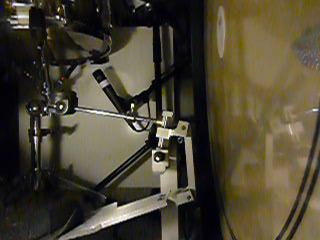
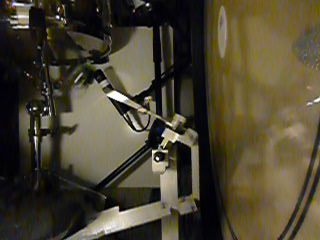
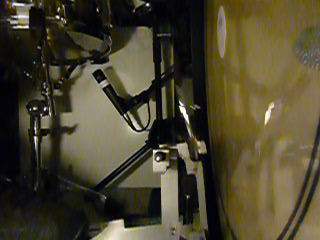
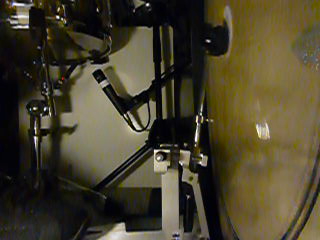
Note the white dots on the center-of-axis as well on the mallet. These were added in order to be able to identify the exact mallet and origo positions in each image.
Meaurements
Single stroke
| Position | Vector | Length (px) | Angle (dgr) | Angle diff (dgr) | Angle speed (dgr/s) |
|---|---|---|---|---|---|
| 0 | (-255,391) | 466.80 | 0.00 | 0.00 | 0.00 |
| 1 | (-247,394) | 465.02 | 1.03 | 1.03 | 226.07 |
| 2 | (-235,405) | 468.24 | 2.99 | 1.96 | 431.07 |
| 3 | (-210,420) | 469.57 | 6.55 | 3.56 | 783.04 |
| 4 | (-176,440) | 473.89 | 11.31 | 4.76 | 1048.00 |
| 5 | (-134,458) | 477.20 | 16.80 | 5.49 | 1208.50 |
| 6 | (-74,480) | 485.67 | 24.35 | 7.54 | 1659.71 |
| 7 | (-6,491) | 491.04 | 32.41 | 8.06 | 1774.08 |
| 8 | (73,493) | 498.38 | 41.53 | 9.12 | 2007.03 |
| 9 | (146,480) | 501.71 | 50.03 | 8.50 | 1868.96 |
| 10 | (232,451) | 507.17 | 60.33 | 10.30 | 2266.84 |
| 11 | (240,446) | 506.47 | 61.40 | 1.06 | 233.99 |
| 12 | (229,452) | 506.70 | 59.98 | -1.42 | -311.73 |
A plot of the angle velocities reveal a rather 'jaggy' picture:
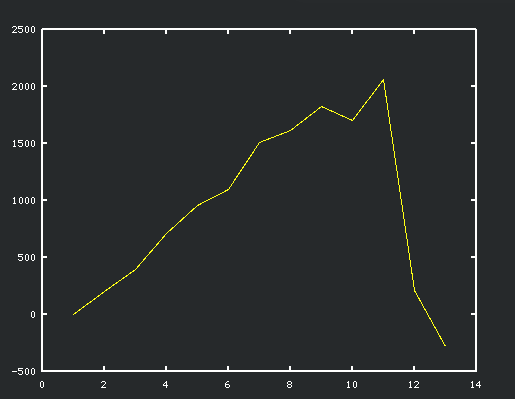
Stroke sequence
| Position | Vector | Length (px) | Angle (dgr) | Angle diff (dgr) | Angle speed (dgr/s) |
|---|---|---|---|---|---|
| 0 | (-255,391) | 466.80 | 0.000000 | 0.000000 | 0.000000 |
| 1 | (-247,394) | 465.02 | 1.027597 | 1.027597 | 205.519334 |
| 2 | (-235,405) | 468.24 | 2.987024 | 1.959427 | 391.885459 |
| 3 | (-210,420) | 469.57 | 6.546291 | 3.559267 | 711.853364 |
| 4 | (-176,440) | 473.89 | 11.309932 | 4.763642 | 952.728338 |
| 5 | (-134,458) | 477.20 | 16.803111 | 5.493178 | 1098.635630 |
| 6 | ( -74,480) | 485.67 | 24.347241 | 7.544131 | 1508.826102 |
| 7 | ( -6,491) | 491.04 | 32.411225 | 8.063984 | 1612.796717 |
| 8 | ( 73,493) | 498.38 | 41.534099 | 9.122874 | 1824.574854 |
| 9 | ( 146,480) | 501.71 | 50.029355 | 8.495256 | 1699.051165 |
| 10 | ( 232,451) | 507.17 | 60.333194 | 10.303839 | 2060.767896 |
| 11 | ( 240,446) | 506.47 | 61.396774 | 1.063580 | 212.715922 |
| 12 | ( 229,452) | 506.70 | 59.979810 | -1.416964 | -283.392753 |
The graph of these angle velocities show a picture rather more 'smooth' than the one rendered from the single stroke:
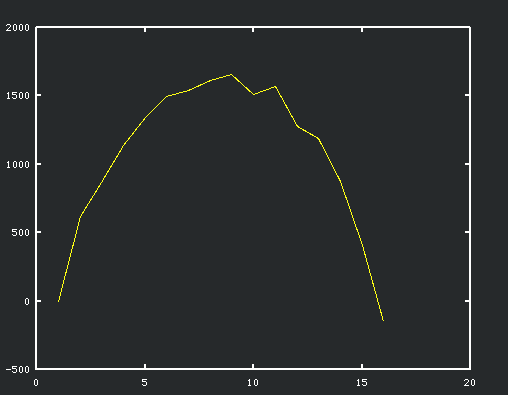
Evaluation
Samplerate
The maximum angle velocity was found in the single stroke and was 2266.84 degrees per second.
That the maximum angle velocity should be found in the stroke type is not surprising since a single stroke is the result of the hardest foot impact on the pedal.
If we assume the target latency to be at most 1ms and we assume that the software is responding in the area of microseconds and therefore negligible we can estimate the target ADC sampling resolution.
Lets start by pointing out that since the video framerate was 220fps each frame represent a state in 4.55ms intervals; ie. we are looking for something around at least 5 times more accurate.
The single stroke took 11 frames in total which is 50ms and during this time the mallet moved 61.4 degrees, resulting in a minimum resolution of 1.23 samplings per millisecond.
However, if we look at the diff in the last two velocities before the impact it was 10.3 degrees in 4.55ms it is evident that the minimum resolution should be higher, namely 2.26 samplings per millisecond.
Ergo: A sampling of approximately 2kHz should be sufficient.
However … the result of this mechanism is the playing of a sample at probably 44.1kHz or 48kHz and in order to avoid phasing problems when mixing with the analogue drum sound it should be considered to make the ADC samplerate 44.1kHz or 48kHz as well.
Bit precision
When considering bit precision it is the lowest angle velocity upon impact that are the worst case scenario. If we therefore look at the stroke sequence we can observe a 2.03 degrees between the last two frames, giving 0.446 degrees in the last millisecond. If we divide the entire 84 degree interval into 0.446 degree segments the result is a minimum of 188 steps.
Ergo: A bit precision of 8 should be sufficient.
However … since we cannot assume that we will work within the entirety of the bit span of the ADC it should be noted that the 8 bit precision is the used number of bits for the mallet swing and a substantial amount of headroom should be added in order to match different spring types and initial tensions. How much 'substantial' is in this case I am not able to evaluate in this article.
Conclusion
Since this experiment has not been performed by the fastest or hardest hitting drummer in the world, or the most latency sensitive one for that matter, we should increase both samplerate and bit precision in order to make sure all drummers are covered.
If say the drummer hits twice as hard (double the angle velocity) and cannot accept latency at more than 0.5ms the calculations from above will be:
Samplerate: 2 * 2.03 degrees in 4.55ms = 8kHz sampling (but still it should be considered to use 44.1kHz or 48kHz to avoid phasing problems)
A very slow stroke is the worst case scenario when considering the bit precision since we need more steps in the final steps of the swing. If say the angle velocity is half of the measured one and the drummer is sensitive to latencies above 0.5ms the number of needed steps will go up by factor of 4:
Bit precision: 188 * 4 steps = 10 bit precision + headroom.
